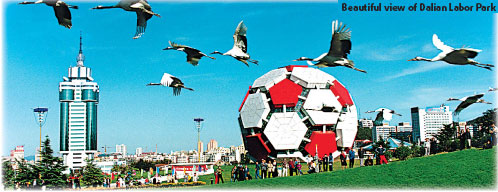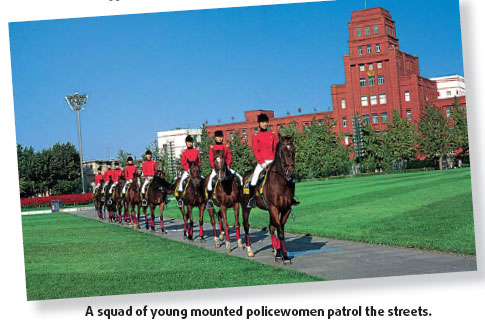Dalian dedicated to social progress
Updated: 2007-09-06 06:26

Dalian, a major coastal city in Northeast China's Liaoning Province, has laid a lot of emphasis on addressing social causes, with the result that great progress has been made in education, public health and culture, according to the Dalian municipal government.
The municipal government invested 420 million yuan in 2004 to transform the dilapidated buildings in rural schools, construct a standard senior middle school for each of the three prefecture-level cities in the northern part of Dalian, and encourage senior middle school education in the city.
In 2006, 130 million yuan was invested to implement free compulsory education in rural areas and support rural schools.

Construction of the public health system has also seen steady progress. In 2005, 270 million yuan was allocated to build and renovate county-level and township public health facilities in rural areas. A new cooperative medical system covering all rural areas has been established, with 2.117 million rural residents, about 87 percent of Dalian's total population, participating in it last year.
The average fund level was 55 yuan per capita in 2006, the highest in the province. The municipal government will invest 150 million yuan to raise the standard to 80 yuan and 90 percent of the people are benefited from the system.
The municipal government has invested over 740 million yuan in cultural causes since 2003. The series of "Building a cultural Dalian" activities conducted over the past four years have enriched the cultural life of the city.
Popular sports and competitive sports have advanced. The annual Dalian International Walking Festival and the Dalian International Marathon have gained fame. Dalian was selected as China's only International Walking City last year. More than 200,000 people attended this year's walking festival, a world record.
Ecological environment
The city of Dalian has well implemented the concept of scientific development in recent years, and is making sure that the environment is not sacrificed for economic development by focusing on promoting harmony between human beings and nature.
Dalian's efforts to reduce energy consumption and control emission have met with good results. Last year, total energy consumption per GDP unit decreased by 4.4 percent and the total emission of major pollutants was reduced by 2.5 percent. According to the national and provincial examination indexes on the emission of COD (chemical oxygen demand), sulfur dioxide, soot and industrial dust, Dalian is one of the least polluted areas in the province and the nation.
When the steel and chemical plants move out of the city proper, the emission of industrial dust in the urban districts will be further reduced by 70 percent.
Overall environment of the city has seen improvement. The comprehensive harness projects on Mianhuadao slag field and Lixia River have been completed. A total of 31 small mines in Ganjingzi District have been closed to reduce dust emission and optimize the industrial structure. Five sewage treatment plants are under construction, the completion of which will raise the sewage treatment level of Dalian to 90 percent from the current 70 percent. A modern refuse power plant is also in the pipeline.
In 2003, Dalian was awarded the title of National Model City in Environmental Protection. Last year, Wafangdian of Dalian was the first prefecture-level city in Northeast China to win the honor.
Further, six forest parks have been built in the city. Xijiao Forest Park, which occupies an area of 300 sq km, is set to be Dalian's natural oxygen bar. The city has made annual investments of over 70 million yuan for afforestation over the past three years, and 100 million trees are planted every year. The forest cover rate increased to 42 percent from 38.2 percent in 2000. The average public green per capita has reached 10 sq m.
Improved livelihood for people
Authorities channeled over 4 billion yuan into measures to improve people's livelihood in 2006, which benefited nearly 3 million residents. The urban registered unemployment rate decreased to 2.9 percent last year and further decreased to a record low of 2.6 percent in the first five months of the current year.
The urban minimum living allowance standard rose to 280 yuan per month in 2006, from 240 yuan earlier, ranking ninth among the 36 large and medium-sized cities in the country.
The rural minimum living allowance standard rose to 1,650 yuan a year from 920 yuan, topping the province, while the average retirement pension level rose to 868 yuan from 705 yuan in 2005.
The minimum wage level increased to 600 yuan from 450 yuan and the unemployment insurance benefit rose from 245 yuan to 360 yuan. The municipal government has implemented relief measures to help the urban poor, as well as policies for migrant workers to receive medical insurance and work-related injury insurance. A special fund has been established to grant subsidies to the heating expenses of the urban poor in the winter
The average disposable income of Dalian's urban residents was 11,934 yuan in 2005 and 13,350 yuan in 2006, the highest in Northeast China and above average among coastal cities.
In the past few years, the municipal government of Dalian has allocated 1.5 billion yuan in transfer payments to subordinate districts and counties to improve the industrial level of rural areas and raise farmers' incomes.
Last year, the average disposable income of farmers was 6,984 yuan, 18.3 percent higher than that in 2005.
Commercial modernization
Aiming to develop an advanced level of commerce with a rational layout and distinctive characteristics in a fine environment, Dalian has constructed large shopping centers and commercial streets in the city proper and a modern circulation network in rural areas.
Special counters have been set up to sell locally produced quality agricultural and sideline products. The Three-Green Project to promote green consumption, foster green market and create a green channel, and the Safe Food Project have had positive effects on development.
(China Daily 09/06/2007 page61)
|
|
|
||
|
||
|
|
|
|